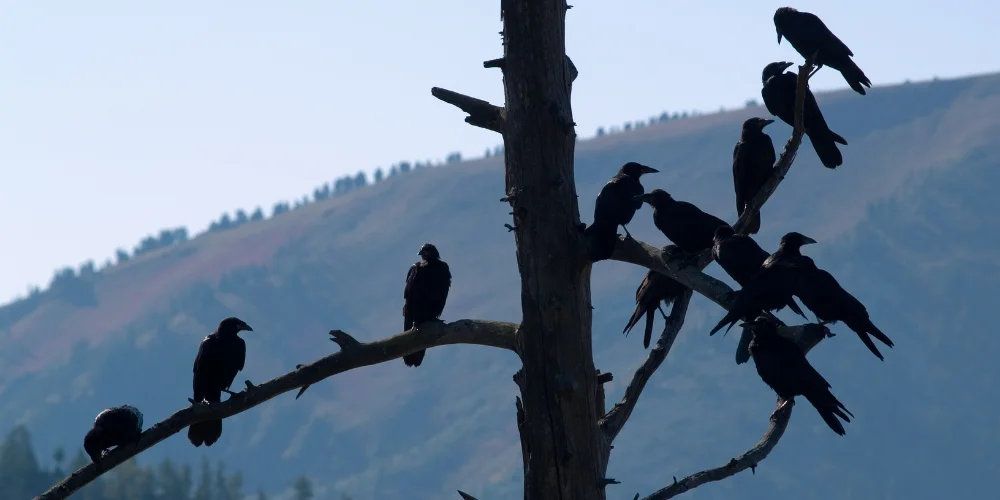Crows have a high level of intelligence along with ravens and other corvids. Lots of people want to know if crows can speak. Because it’s hard to tell the difference between real and fake videos online, it can be difficult to tell whether videos of talking crows are real or fabricated. So, can crows talk?
Crows can mimic human speech they often hear. However, like other birds in the corvid family, crows typically imitate human speech when living in captivity. It’s important to note that this “speech” is mimicry, not communication.
Can Crows Talk like Parrots?
Parrots are well-known for their ability to imitate human speech. Some species of parrots can learn up to a thousand human words and phrases. Because we are fascinated with birds that speak like humans, we may wonder how well crows can talk like parrots.
Crows can talk like parrots, although crows are less likely to imitate human speech.
The ability to mimic human speech varies between crows, with only crows raised in captivity learning human words and phrases. Crows and other corvids can learn to mimic about 100 human words and phrases.
Can You Teach a Crow to Talk like Humans?
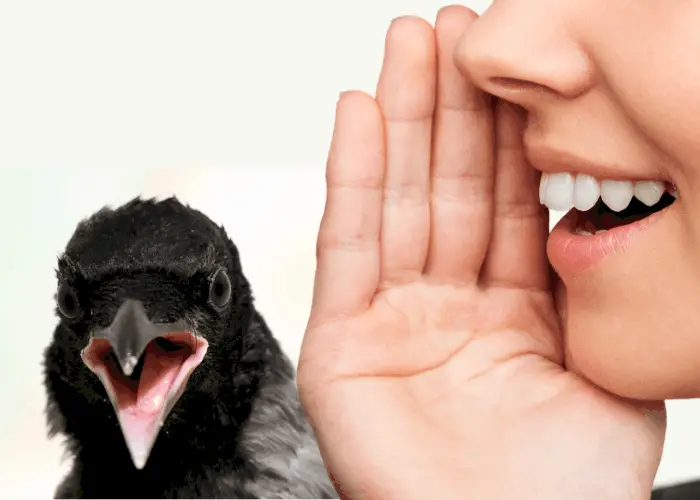
Humans have a fascination with animals that can imitate human speech. Because there’s evidence that crows can form human words, many people wonder if they can talk in full sentences like humans.
Crows are very intelligent animals and, if trained, can learn to mimic the human voice and use simple tools to manipulate objects.
-Connecticut Department of Energy and Environmental Protection
Although there’s strong evidence that crows are intelligent, they cannot talk like a normal person would do. When they form words or phrases, it’s only mimicry. While it may sound like a person’s speech, they likely don’t understand the meaning of the words or when to use them.
This is similar to the way we may imitate crow speech. While we can make “cawing” noises, we do not understand the meaning behind particular cawing patterns.
4 Fun Facts about Crows

Besides their ability to speak and imitate human speech, crows are fascinating creatures. Below are four fun facts about crows.
- They get creative when looking for food.
Crows are both opportunistic and creative. They have been observed using pieces of bread as bait to lure fish to the water’s surface. When the fish approach, they catch and consume them.
They’ve also been known to steal food from other animals. One crow may distract an animal while another steals its food.
Their most notable creativity is the way they get food from hard shells. Like other bird species, they often drop snails from great heights to crack open their shells.
However, many crows take it further by taking walnuts to the roads. After cars drive over them, cracking the shells, crows wait for the road to be clear and retrieve their nuts.
- They’re as intelligent as human children up to five or seven years old.
Crows can pass intelligence tests at a similar level to children between the ages of five and seven. Other tests, their use of tools, and planning behaviors indicate that crows have significant intelligence. One study found that they can plan behaviors three steps into the future.
- They hold funerals when another crow dies.
Crows hold “funerals” for fallen friends. These funerals may be quiet or loud. Whether alone or in a group often crows vigil over their deceased friend for several days like a human.
Although scientists may never learn what’s going on in their minds, their intelligence indicates that they may experience genuine grief.
Some scientists believe these vigils are a method for learning about dangers. Viewing their fallen friend’s body, a crow can prevent similar deaths by learning about certain risks.
- Crows mate for life, despite the fact they’re genetically promiscuous.
Crows are social and family-oriented birds. Mated pairs typically stay together for life. Although they stay with the same partner, genetic analysis has shown that male crows typically only father 80% of their “family’s” offspring.
Observation of crow behavior has also shown that some crows live double lives. They travel between separate families, maintaining two separate lives.
Are Crows as Smart as Ravens?

Ravens are known for their intelligence, often touted as the most intelligent bird species because crows and ravens belong to the same family of birds, many wonders if crows might be as intelligent as ravens.
Research indicates that ravens may be a little smarter than crows. Ravens can imitate the calls of other birds, like geese and crows. They can also do flying stunts to attract potential mates.
Full-blown cognitive skills were already present at the age of four months with subadult ravens’ cognitive performance appearing very similar to that of adult apes in tasks of physical (quantities, and causality) and social cognition (social learning, communication, and theory of mind).
– Nature.com Scientific Studies
Birds in the Corvidae family have more neurons than most mammals. Although their brains are significantly smaller, they have higher intelligence than many mammals, including some primates. Their intelligence is often determined by their ability to imitate human speech and solve problems.
Raven Intelligence
Research shows ravens can pre-plan tasks, as published in a study in the Science journal. For centuries, scientists believed pre-planning tasks were a skill unique to humans and some primates. However, this research shows that ravens have significant planning skills.
One study showed that when ravens were shown how to use a tool to retrieve food, they remembered what tool to use and how nearly 24 hours later.
When presented with a selection of objects, the ravens in the study chose the one needed to retrieve food and then used it to get a treat. Studies show that many monkeys may not even have this skill.
Crow Intelligence
Crows do almost as well at solving problems and completing intelligence tests. One place where crows outpace their raven counterparts is in their ability to remember human faces. They specifically use this skill to remember when a person is a treat.
Researchers conducted a study where the researchers wore masks while holding dead crows and laying out food. Living crows in the area harassed them.
When they returned weeks later, wearing the same masks, the crows remembered their faces and resumed their harassment. Even though the group didn’t have dead crows with them this time, the crows remembered their former behavior.
Crows tend to be warier than new humans, but they show comfort around humans they’ve had positive interactions with. When they grow comfortable with researchers, they are often eager to approach them for treats or other exchanges.
How to Tell the Difference between a Crow and a Raven

Crows and ravens are both black birds in the crow or Corvidae family. All 120 species in the crow family have a medium body size, bulky bills, and large feet. Crows, ravens, rooks, and jackdaws belong to the family Corvidae.
Ravens usually have larger bills and larger bodies. They also have different flight patterns and a shaped tail than their crow relatives.
The average wingspan for a raven is between 3.5 and 4 feet. Meanwhile, the crow has a wingspan of only 2.5 feet. Because of this difference in size, crows typically weigh half as much as ravens.
Ravens have wedge-shaped or diamond-shaped tails with somewhat pointed tips. Meanwhile, crows have fan-shaped tails. Ravens also have more sheen on their feathers, appearing wet or oily. In comparison, crows often have duller feathers.
Ravens do not typically appear in populated areas. If you see a large black bird in the city, it’s more likely to be a crow than a raven. Ravens are also known to soar more. If you see a black bird soaring for more than a few seconds, it’s more likely to be a raven than a crow.
Can Ravens Talk Like Crows?
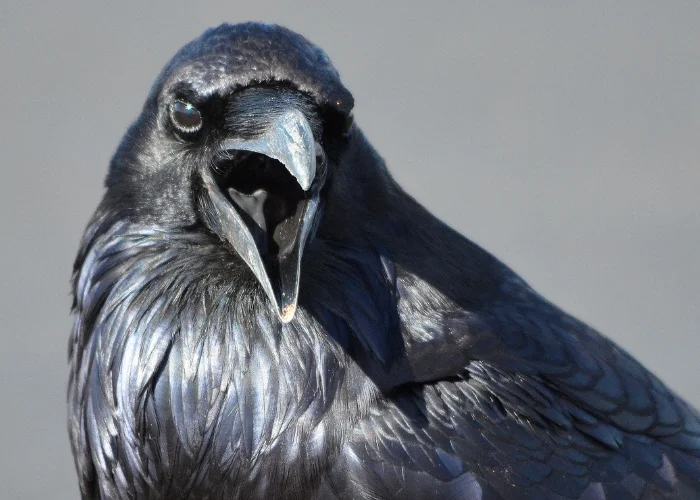
Ravens can talk, despite their slightly inferior intelligence when compared to crows. Since crows and other bird species can imitate speech, it’s natural to wonder whether ravens can also talk.
Ravens in the wild do not appear to mimic other sounds. The ability to replicate human speech has been clearly observed only in ravens raised in isolation.
– U.S. National Park Service
Just like crows, ravens can copy human speech. However, they only mirror human speech when in captive or close contact with humans. They use their language to indicate food locations and dangers when communicating with other ravens.
Ravens can typically learn about 100 human words, compared to the nearly 1000 words learned by African gray parrots. However, they can also mimic sounds like car alarms and animal calls.
These other imitations are significantly better than parrots’ imitations of these sounds.
They use their intelligence to communicate with other ravens. These smart birds can also make rasping calls, knocking noises, and singing sounds. Evidence suggests they use these sounds to scare away potential predators.
5 Fun Facts about Ravens
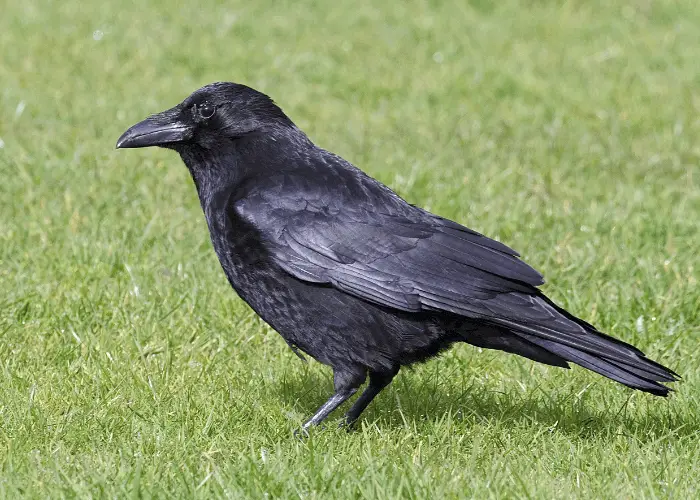
Ravens are also in the Corvidae family. Tests indicate that ravens are typically more intelligent than their crow counterparts. Below are five more fun facts about ravens.
- They love to play.
People have observed ravens playing in the snow. In some cases, they’ve used snow-covered roofs as slides. In other situations, they’ve been seen rolling down snowy hills.
Ravens use sticks, pinecones, balls, and rocks to create toys. They play with each other and alone. They’ve sometimes been observed taunting or mocking other animals for fun. Because of this, they’ve gained a reputation for their mischief.
- They use gestures to communicate.
Ravens point with their beaks like we often point with our fingers. They use these gestures to indicate an object or threat to another bird. Ravens also hold up objects to get attention. Besides humans and primates, ravens are the only animals to communicate with gestures.
- They are very adaptable.
Ravens can live in a variety of habitats. Because they’re scavengers, they can survive on whatever food is available. When scarcity exists, they often trick other animals out of food. One raven may distract the animal while another steals its food.
- They show sympathy toward other ravens.
Although ravens are known for being mischievous creatures, they appear to show empathy toward other ravens. Other ravens may be consoling their defeated friend when a friend loses a fight.
- They hold grudges against other birds.
Ravens remember other birds they’ve previously encountered. If the bird is one they like, they may respond in friendly ways for three years or more.
One study found that ravens can hold grudges for weeks. In the study, they gave the ravens pieces of bread they could exchange with researchers for a piece of cheese.
One researcher took the bread and ate it and the cheese, cheating the raven out of its reward. The ravens that were cheated remembered and refused to trade with that human researcher, even weeks after the incident.
Conclusion
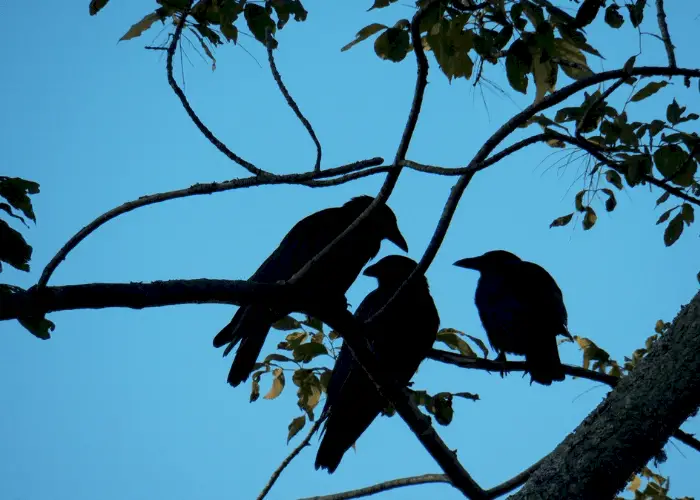
Crows and ravens are intelligent and fascinating birds. Although they have a rich language to communicate with their species, crows and ravens can both reproduce human speech.
Despite their intelligence, mimicking human speech does not indicate that they understand human language. Even so, their intelligence rivals both primates and small children.
RELATED QUESTIONS:
Can Crows Talk if You Split Their Tongue?
A crow can learn to talk like a human when raised in a restricted environment. A common belief is that you need to split a crow’s tongue for it to be able to speak.
Can crows talk if you split their tongue? It is a common misconception that splitting a crow’s tongue will help it speak. Splitting a crow’s tongue is both cruel and unnecessary.
Although humans use their lips, tongue, and teeth to speak, crows do not. Although they have tongues, crows do not have lips or teeth. Their tongues aren’t used to produce sound.
Crows use their syrinx to mimic words of humans (and make other sounds). They move air across their syrinx, the crow equivalent of our larynx, to create various sounds.
Crows have developed more control over their speech than most other birds. Although they typically use this skill to mimic sounds, they can learn around 100 human words by mimicking the sounds of human speech.
Can Crows Talk to Each Other?
We may never fully understand the language crows use to communicate with each other. However, scientists have extensively observed crows and how they communicate with each other.
This research has gleaned some important information about crow’s speech.
Crows speak to each other with a variety of “caw” sounds. These highly social birds are in constant communication with each other. Research suggests that their use of communication is a sign of their high intelligence.
Like humans, crows often have voices that vary between individual crows. However, their voices are largely similar, even between the forty species worldwide.
Like all birds in the corvid family, crows are highly intelligent and use speech to communicate with each other.
Although we don’t know everything about their language, researchers believe they communicate with different spacing, speed, and tones between caws.
While a few rapid-paced caws may indicate one thing, a slow caw with a pause before a longer caw may mean another.
Crows use this language to share information with other nearby crows, especially when danger is present.
During winter, crows gather in huge roosts of thousands of crows. In these social gatherings, crows use a variety of caws to communicate with each other socially.
Can Crows Speak English?
People in English-speaking countries are often curious about whether or not crows can speak English. With their high intelligence, it does not seem like a stretch to assume that crows can speak different languages.
Despite the interest in imitating languages, crows cannot naturally speak English. They can mimic human language, especially when in captivity.
However, their imitation of phrases in certain languages does not indicate their ability to speak and understand them.
WORTH A LOOK: Do Crows Have a Sense of Smell?
REFERENCES:
1. Syrinx (bird anatomy). (2022, November 12). In Wikipedia. https://en.wikipedia.org/wiki/Syrinx_(bird_anatomy)


